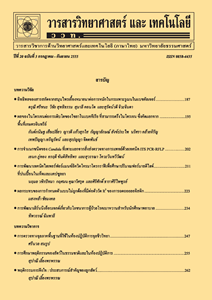ผลของไอโอไดด์และไอโอเดตต่อการเจริญเติบโตและการสะสมในผักบุ้งจีนที่ปลูกในระบบไฮโดรโปนิกส์
Main Article Content
Abstract
ศึกษาผลของไอโอดีน 2 รูป: ไอโอไดด์ (I-) และไอโอเดต (IO3-) ที่ความเข้มข้น 6 ระดับ คือ 0, 1, 5, 10, 50 และ 100 ไมโครโมลาร์ต่อการเจริญเติบโต ผลผลิตและการสะสมในผักบุ้งจีนพันธุ์ยอดไผ่ 9 ในระบบไฮโดรโปนิกส์แบบสารละลายที่มีการเติมอากาศ วางแผนการทดลองแบบสุ่มสมบูรณ์ (CRD) และหาปริมาณไอโอไดด์และไอโอเดตในพืชโดยใช้วิธี Potentiometry ร่วมกับ Ion Selective Electrode (ISE) และ Flow Injection Analysis (FIA) ตามลำดับ จากการทดลอง พบว่า ต้นที่ปลูกในสารละลายธาตุอาหารที่ไม่เติมไอโอดีนมีเส้นผ่าศูนย์กลางลำต้นมากที่สุดและแตกต่างอย่างมีนัยสำคัญกับต้นที่เติมไอโอไดด์ความเข้มข้น 10 - 100 ไมโครโมลาร์และไอโอเดตทุกความเข้มข้น แต่ความสูง จำนวนใบ และน้ำหนักแห้งรากไม่แตกต่างอย่างมีนัยสำคัญ ส่วนน้ำหนักสดและแห้งต้น และน้ำหนักสดรากที่ไอโอเดตความเข้มข้น 1 ไมโครโมลาร์ มีค่ามากกว่าและแตกต่างอย่างมีนัยสำคัญยิ่งกับที่เติมไอโอไดด์ความเข้มข้น 10 ไมโครโมลาร์หรือมากกว่า และไอโอเดตความเข้มข้น 100 ไมโครโมลาร์ ปริมาณไอโอไดด์สะสมในต้นมากกว่าราก และสะสมเพิ่มขึ้นอย่างมีนัยสำคัญยิ่งเมื่อความเข้มข้นของไอโอไดด์ในสารละลายธาตุอาหารเพิ่มขึ้น ส่วนปริมาณไอโอเดตในต้นและรากสูงสุดที่ไอโอเดตความเข้มข้น 100 ไมโครโมลาร์ จากการทดลองสามารถสรุปได้ว่า การเติมไอโอไดด์ความเข้มข้น 1 ไมโครโมลาร์ในสารละลายธาตุอาหารไม่มีผลต่อการเจริญเติบโตและผลผลิตของผักบุ้งจีนพันธุ์ยอดไผ่ 9 และมีปริมาณไอโอไดด์สะสมในต้นเท่ากับ 1.32 ± 0.15 มิลลิกรัมต่อกิโลกรัมน้ำหนักสด ซึ่งปริมาณสะสมดังกล่าวมากกว่าปริมาณไอโอเดตที่สะสมเมื่อเติมที่ความเข้มข้นเดียวกัน และเพียงพอต่อการเสริมไอโอดีนเพื่อการบริโภค
คำสำคัญ : การเจริญเติบโต; ผักบุ้งจีน; ไฮโดรโปนิกส์; ไอโอไดด์; ไอโอเดต
Abstract
The effects of two iodine species, iodide (I-) and iodate (IO3-), with 6 different concentrations: 0, 1, 5, 10, 50 and 100 µM on growth, yield and iodide – iodate accumulations of water convolvulus cv. Yodpai 9 grown in solution culture with air pump were investigated. The experiment was arranged in Completely Randomized Design (CRD). The accumulations of iodide and iodate in plant tissue were determined using Potentiometry with Ion Selective Electrode (ISE) and Flow Injection Analysis (FIA) methods, respectively. The greatest of stem diameter occurred in the control treatment which was significantly different with those at 10 – 100 µM iodide and at all concentrations of iodate. However, plant height, leaf number and root dry weight were insignificantly different among the treatments. The fresh and dry weight of shoot and dry weight of root at 1 µM iodate were significantly higher than those at 10 µM iodide or higher and at 100 µM iodate. The accumulation of iodide in shoots was higher than in roots and significantly increased when iodide concentrations in the nutrient solution increased. The highest concentrations of iodate occurred in shoots and roots at 100 µM iodate. The results from this experiment indicated that addition of 1 µM iodide in the nutrient solution had no effect on the growth and yield of water convolvulus cv. Yodpai 9. The iodide accumulation in shoots were 1.32 ± 0.15 mg/kg fresh weight which were higher than the iodate accumulation in the plant shoots at the same additional concentration and are probably enough to supplement iodine through dietary intake.
Keywords: growth; hydroponics; iodate; iodide; water convolvulus


